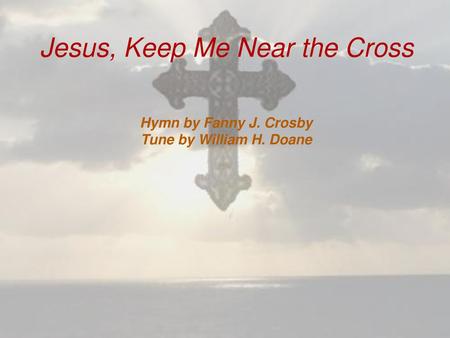

It was also during this time that Kirkpatrick was given command over all of the music at Grace Methodist Episcopal church. The death of Kirkpatrick’s wife in 1878 acted as a catalyst in his life to give up the trade and devote himself fully to music and composition.īetween 18, Sweeney and Kirkpatrick published 49 major books.

They soon became partners in their musical careers. It was also during this time that he was introduced to John R.

Over the next 11 years, Kirkpatrick was elected lead organist for the Ebenezer Methodist Episcopal Church, studied the pipe organ, continued in vocal lessons, and began publishing more and more hymns. He returned to Philadelphia and supported his wife by working in carpentry. This lasted until October 1862, when under general orders, the position was terminated. Not long after the marriage, he enlisted in the 91st Regiment of the Pennsylvania Volunteers as a Fife-Major. In 1861, William Kirkpatrick married his first wife. Leopold Meignen, under whose tutelage he devoted himself primarily to the study of music focusing on theory and composition. His involvement with the Harmonia Society introduced him to another man, Dr. Jenks who helped him publish his first collection of hymns, Devotional Melodies, in 1859. In 1855, he became involved in the Wharton Street Methodist Episcopal Church serving the choir with his musical talent and teaching Sunday school.īeginning in 1858, Kirkpatrick began working with A.S. He joined the Harmonia and the Haydn Sacred Music Societies where he was exposed to many great composers. Kirkpatrick was a versatile musician playing the cello, fife, flute, organ, and violin. It was here that he studied vocal music under Professor T. In 1854, he moved to Philadelphia to study music and carpentry. William was exposed to and given formal training in music at a very young age. They did, however, give birth to a daughter on the ship in transit. William did not accompany his parents on the initial immigration as he was too young and they wished to be settled before bringing him to America. The family immigrated to Philadelphia on 5 August 1840, living first in Duncannon, Pennsylvania. It could also be used as instrumental music preceding Communion, such as in a handbell arrangement like “Near the Cross.Kirkpatrick was born in the Parish of Errigal, Keerogue, County Tyrone, Ireland to a schoolteacher and musician, Thomas Kirkpatrick and his wife, Elizabeth Storey. This hymn is perfect for a contemporary or blended worship service, as it fits well with modern songs such as “The Power of the Cross,” as in the choral arrangements “Near the Cross,” or “Keep Me Near the Cross,” both of which can be accompanied by piano alone, or with optional instruments. This hymn is best suited to Lent or Holy Week. If it is too fast, it sounds like a dance, which is not appropriate to the theme of the text, but an excessively slow tempo is depressing, while the text gives hope. This tune should be sung at a moderate tempo.

The stanza and the refrain are in two phrases each, clearly marked by the ending long notes. He wrote the tune in 1869 and it was first published with the text in Bright Jewels. Doane, who often collaborated with Crosby, is the composer. The tune for this hymn was actually written before the text, but it was named after the text, NEAR THE CROSS. The third stanza is a prayer that the Christian would always remember God's love as shown on the cross, and the fourth looks forward to heaven. The first stanza describes redemption through Jesus' blood, and the second, the need of humanity for salvation. Each stanza has a slightly different aspect of the main theme. The first line of each stanza contains the phrase “near the cross,” emphasizing the value of Christ's redeeming work there. The fourth stanza (“Near the cross I'll watch and wait”) is occasionally omitted. Crosby wrote four stanzas and a refrain, which most hymnals have kept. The text and tune were published together in Bright Jewels for the Sunday School in 1869. In 1869, Fanny Crosby was shown a tune by William Doane, for which she wrote this text.


 0 kommentar(er)
0 kommentar(er)
